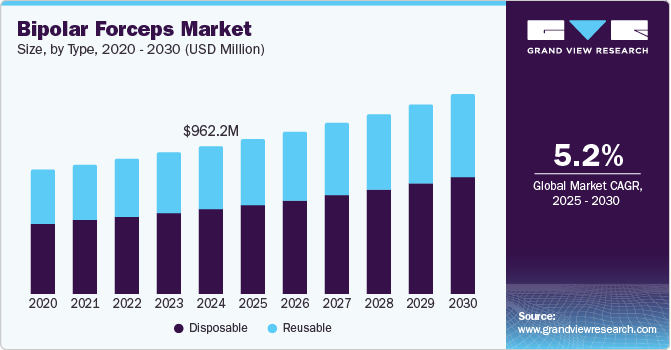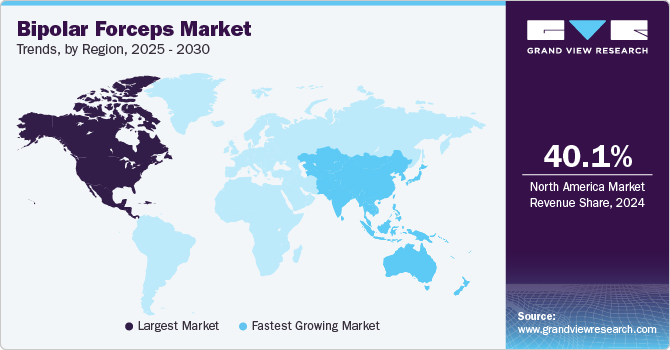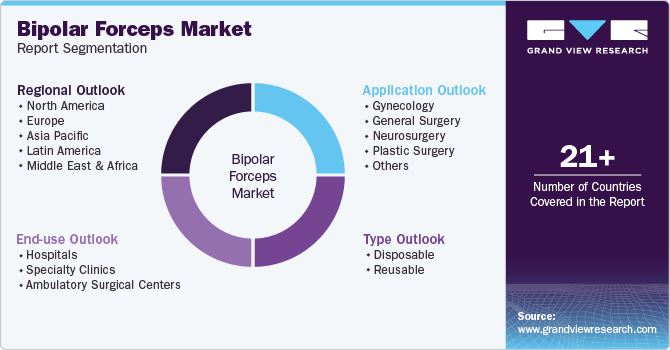
Bipolar Forceps Market Size, Share & Trends Analysis Report By Type (Disposable, Reusable), By Application (Gynecology, General Surgery, Neurosurgery), By End-use, By Region, And Segment Forecasts, 2025 - 2030
- Report ID: GVR-4-68039-143-5
- Number of Report Pages: 100
- Format: PDF
- Historical Range: 2018 - 2023
- Forecast Period: 2025 - 2030
- Industry: Healthcare
Bipolar Forceps Market Size & Trends
The global bipolar forceps market size was estimated at USD 962.2 million in 2024 and is projected to grow at a CAGR of 5.2% from 2025 to 2030. The rising prevalence of chronic diseases such as cancer, cardiovascular conditions, and neurological disorders is driving the market growth. As minimally invasive surgeries become more popular, bipolar forceps are increasingly preferred for their precision and safety. They allow for controlled tissue coagulation, reducing risks such as burns or excessive bleeding. In addition, their high precision in dissection and coagulation makes them ideal for delicate surgeries. The growing use of robotic-assisted surgeries is boosting the demand for specialized surgical tools such as bipolar forceps.

In addition, digital integration in bipolar forceps incorporates tools such as force sensors and energy output controls, allowing real-time monitoring during surgeries. This technology gives surgeons better control over the energy delivered to tissues, improving precision and safety. The sensors detect pressure and adjust the power output, ensuring optimal performance throughout the procedure. Therefore, this technology reduces the risk of tissue damage, improves patient outcomes, and makes bipolar forceps more attractive to surgeons seeking enhanced control and efficiency.
Moreover, incorporating force sensors in bipolar forceps enables automatic adjustments to power output based on detected pressure. For instance, a study published in the Journal of Surgical Research highlighted that bipolar forceps are more effective than monopolar forceps in reducing tissue damage during laparoscopic procedures and achieving hemostasis, demonstrating the benefits of advanced technology in surgical tools.
Type Insights
The disposable segment dominated the market with a revenue share of 57.4% in 2024 and is projected to experience the fastest CAGR of 5.5% over the forecast period, driven by increasing demand for hygiene, safety, and convenience in surgical procedures. As healthcare facilities prioritize infection control and reduce the risk of cross-contamination, disposable bipolar forceps offer a cost-effective and safer alternative to reusable instruments. Moreover, the rising preference for minimally invasive surgeries and the growing focus on patient outcomes further fuel the adoption of disposable surgical tools.
The reusable bipolar forceps segment is projected to experience a significant CAGR over the forecast period, attributed to the growing demand for cost-effective and sustainable surgical solutions. As reusable instruments can be sterilized and used multiple times, they are favored by hospitals and surgical centers looking to reduce waste and operational costs. As healthcare facilities seek to reduce long-term expenses while maintaining high-quality standards, reusable bipolar forceps offer a durable, environmentally friendly option. The increasing focus on instrument longevity and the ability to withstand multiple sterilization cycles further drive their adoption. Therefore, the reusable bipolar forceps market is expected to see significant growth and adoption over the forecast period.
End-use Insights
The hospital segment dominated the market with the largest revenue share in 2024, driven by the high volume of hospital elective and emergency surgeries. In addition, hospitals are increasingly adopting minimally invasive surgical techniques, which require precise instruments such as bipolar forceps for effective tissue coagulation and dissection. Moreover, these procedures offer faster recovery times and reduced patient risk, benefiting from the high accuracy that bipolar forceps provide. Therefore, hospital infrastructure, resources, and ability to invest in advanced surgical technologies make them a key driver of bipolar forceps adoption.
The ambulatory surgical centers segment is projected to grow at a significant CAGR over the forecast period, fueled by the increasing preference for outpatient surgeries. These procedures offer shorter recovery times, reduced hospital stays, and lower costs than traditional inpatient surgeries. In addition, ambulatory surgical centers specializing in outpatient care are adopting advanced surgical tools such as bipolar forceps to maintain high-quality standards while keeping operational expenses low. Moreover, minimally invasive surgeries, such as laparoscopic and endoscopic procedures, benefit from the high accuracy and control offered by bipolar forceps. Therefore, the increasing affordability, access to outpatient care, and availability of technological advancements will continue to drive the demand for bipolar forceps over the forecast period.
Application Insights
The general surgery segment dominated the market with the largest revenue share in 2024 driven by the widespread use of bipolar forceps in common procedures such as appendectomies, hernia repairs, and gallbladder removals. As these surgeries remain frequent, the demand for bipolar forceps continues to rise. The growing preference for minimally invasive techniques in general surgery, which require high precision and safety, further boosts the use of bipolar forceps. Their ability to provide controlled coagulation with minimal risks makes them ideal for these procedures. As a result, bipolar forceps play a crucial role in enhancing outcomes in general surgery. This trend is expected to continue as minimally invasive methods become more prevalent.

The gynecology segment is projected to grow at a significant CAGR over the forecast period. Due to the rising prevalence of gynecological conditions such as fibroids, endometriosis, and cervical cancer, which often require surgery. As minimally invasive gynecological procedures, such as laparoscopic and hysteroscopic surgeries, become more common, the demand for precise surgical tools such as bipolar forceps increases. These procedures offer benefits such as smaller incisions, faster recovery, and reduced complications, further supporting the use of bipolar forceps. Their ability to provide controlled coagulation and precision in delicate tissue makes them ideal for gynecological surgeries. As patient outcomes improve and recovery times decrease, the adoption of bipolar forceps continues to rise in this field. This trend reflects the broader shift toward minimally invasive surgery.
Regional Insights
North America bipolar forceps market dominated the global market with a revenue share of 40.1% in 2024, driven by advanced healthcare infrastructure. The increasing prevalence of chronic diseases, such as cancer and cardiovascular conditions, has led to a higher volume of surgical procedures, further boosting demand. Moreover, the rising popularity of robotic-assisted surgeries, especially in the U.S., is driving the use of advanced, high-precision instruments such as bipolar forceps. These factors collectively position North America as the dominant market for bipolar forceps.

U.S. Bipolar Forceps Market Trends
The U.S. bipolar forceps market dominates North America, with a significant revenue share in 2024, attributed to advanced healthcare infrastructure and many well-equipped hospitals. For instance, the growing use of bipolar forceps in robotic-assisted surgeries, particularly with the da Vinci Surgical System, widely adopted in the U.S. for procedures such as prostatectomies, hysterectomies, and heart surgeries, relies on precision instruments such as bipolar forceps for tissue coagulation and dissection. Integrating bipolar forceps with robotic platforms enables surgeons to perform highly precise, minimally invasive surgeries with reduced risk of complications and faster recovery times. This trend drives the demand for bipolar forceps, contributing significantly to the U.S. market dominance in North America.
Asia Pacific Bipolar Forceps Market Trends
Asia Pacific bipolar forceps market is expected to register the highest CAGR of 5.6% over the forecast period. The rapid expansion of healthcare infrastructure, growing healthcare access, and an increasing shift towards advanced surgical technologies. Countries such as Japan and China are witnessing significant improvements in medical facilities, particularly in Tier 2 and Tier 3 cities, contributing to greater adoption of minimally invasive surgeries requiring high-precision instruments such as bipolar forceps. Therefore, this is set to accelerate the adoption of bipolar forceps and drive market growth in the Asia Pacific region.
Japan bipolar forceps market dominates the Asia Pacific region, due to its advanced healthcare infrastructure and widespread adoption of cutting-edge medical technologies. The country’s high volume of surgical procedures, especially in general surgery, gynecology, and urology, drives demand for precision tools such as bipolar forceps. Its aging population, which faces a higher incidence of chronic diseases such as cancer and cardiovascular conditions, further fuels the need for surgical interventions.
Due to minimally invasive surgeries becoming more popular in Japan, the demand for bipolar forceps has increased. In addition, Japan is a leader in medical technology innovation, ensuring the availability of advanced, high-quality surgical instruments. The country’s strong medical research and development sector continuously improves surgical tools, enhancing their effectiveness. These factors collectively make Japan the dominant player in the Asia Pacific bipolar forceps market.
Europe Bipolar Forceps Market Trends
Europe bipolar forceps market held a substantial market share in 2024, driven by the increasing adoption of robotic-assisted surgery and advanced medical technologies. For instance, the European Union's investment in healthcare innovation through the Horizon Europe funding program aims to advance medical technologies and improve surgical outcomes. This program supports the development of cutting-edge surgical tools, including bipolar forceps, aligning with Europe's focus on improving healthcare quality and surgical precision. The growing use of robotic surgery platforms, such as Surgical's da Vinci System, in countries such as Germany and the UK contributes to the increasing demand for bipolar forceps in the region.
Germany bipolar forceps market dominates Europe, with a significant revenue share in 2024, attributed to its advanced healthcare system. The country strongly emphasizes cutting-edge medical technologies, including robotic-assisted surgeries that require precision instruments such as bipolar forceps. In addition, the country is home to many specialized medical centers and hospitals, particularly in cities such as Berlin and Munich, where the latest surgical tools and techniques are widely adopted. Moreover, its strong medical device manufacturing sector and its commitment to healthcare innovation further support the demand for bipolar forceps.
Germany's top hospitals, such as the Charité University Hospital in Berlin and University Hospital Munich, have integrated robotic-assisted surgery into their operating rooms for procedures such as prostatectomies and hysterectomies. These surgeries rely on high-precision tools such as bipolar forceps for effective tissue coagulation and minimal damage to surrounding tissues. Therefore, these factors collectively position Germany as a dominant player in the Europe bipolar forceps market.
Key Bipolar Forceps Company Insights
Some key companies operating in the market include CONMED Corporation, Medtronic, KLS Martin Group, B. Braun SE, and Integra LifeSciences Corporation. Companies are undertaking strategic initiatives such as mergers, acquisitions, and product launches, to expand their market presence and address the evolving healthcare demands through medical device validation and verification.
-
CONMED Corporation offers a range of surgical instruments, including advanced bipolar forceps designed for precision in minimally invasive procedures. Its product includes various models of bipolar forceps for laparoscopic, endoscopic, and robotic-assisted surgeries, with features such as ergonomic designs and enhanced coagulation control.
-
Medtronic offers surgical instruments such as advanced bipolar forceps for precision in tissue coagulation and dissection during minimally invasive surgeries. It also includes Valleylab FT10 Energy Platform, which integrates with bipolar forceps for effective energy delivery in laparoscopic, robotic, and endoscopic procedures.
Key Bipolar Forceps Companies:
The following are the leading companies in the bipolar forceps market. These companies collectively hold the largest market share and dictate industry trends.
- CONMED Corporation
- Medtronic
- KLS Martin Group
- B. Braun SE
- Stryker
- BD
- Johnson & Johnson Services, Inc.
- Integra LifeSciences Corporation
- Stingray Surgical Products, LLC
- Surgical Holdings
Bipolar Forceps Market Report Scope
|
Report Attribute |
Details |
|
Market size value in 2025 |
USD 1.01 billion |
|
Revenue forecast in 2030 |
USD 1.30 billion |
|
Growth rate |
CAGR of 5.2% from 2025 to 2030 |
|
Base year for estimation |
2024 |
|
Historical data |
2018 - 2023 |
|
Forecast period |
2025 - 2030 |
|
Quantitative units |
Revenue in USD million/billion, and CAGR from 2025 to 2030 |
|
Report coverage |
Revenue forecast, company ranking, competitive landscape, growth factors, trends |
|
Segments covered |
Type,application, end-use, region |
|
Regional scope |
North America; Europe; Asia Pacific; Latin America; Middle East & Africa |
|
Country scope |
U.S., Canada, UK, Germany, France, Italy, Spain, Norway, Denmark, Sweden,Japan, China, India, South Korea, Australia, Thailand, Brazil, Argentina, South Africa, Saudi Arabia, UAE, Kuwait |
|
Key companies profiled |
CONMED Corporation; Medtronic; KLS Martin Group; B. Braun SE; Stryker; BD; Johnson & Johnson Services, Inc.; Integra LifeSciences Corporation; Stingray Surgical Products, LLC; Surgical Holdings |
|
Customization scope |
Free report customization (equivalent up to 8 analysts working days) with purchase. Addition or alteration to country, regional & segment scope. |
|
Pricing and purchase options |
Avail customized purchase options to meet your exact research needs. Explore purchase options |
Global Bipolar Forceps Market Report Segmentation
This report forecasts global, regional, and country revenue growth and analyzes the latest industry trends in each sub-segment from 2018 to 2030. For this study, Grand View Research has segmented the global bipolar forceps market report based on type, application, end-use, and region:

-
Type Outlook (Revenue, USD Million, 2018 - 2030)
-
Disposable
-
Reusable
-
-
Application Outlook (Revenue, USD Million, 2018 - 2030)
-
Gynecology
-
General Surgery
-
Neurosurgery
-
Plastic Surgery
-
Others
-
-
End-use Outlook (Revenue, USD Million, 2018 - 2030)
-
Hospitals
-
Specialty Clinics
-
Ambulatory Surgical Centers
-
-
Regional Outlook (Revenue, USD Million, 2018 - 2030)
-
North America
-
U.S.
-
Canada
-
-
Europe
-
UK
-
Germany
-
France
-
Italy
-
Spain
-
Norway
-
Denmark
-
Sweden
-
-
Asia Pacific
-
Japan
-
China
-
India
-
South Korea
-
Australia
-
Thailand
-
-
Latin America
-
Brazil
-
Argentina
-
-
Middle East & Africa
-
South Africa
-
Saudi Arabia
-
UAE
-
Kuwait
-
-
We are committed towards customer satisfaction, and quality service.
"The quality of research they have done for us has been excellent."




